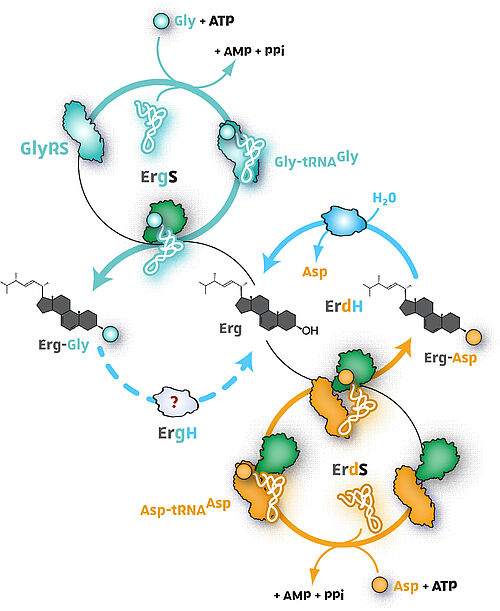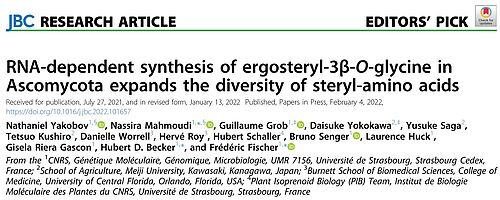Projet ANR "N-FLAMS"
Aspergillus fumigatus (Afm) is an opportunistic pathogenic fungus responsible for invasive aspergillosis whose mortality, despite treatment, remains very high in immunocompromised patients or patients with pulmonary pathologies and/or lesions. As with other fungal pathogens, the emergence of resistance to antifungal agents partly explains this finding, but also a lack of knowledge on the molecular aspects that trigger pathogenesis. In pathogenic bacteria, where these mechanisms have been well studied, it has been observed that a family of enzymes called MprF are able to divert amino acids from protein synthesis and transfer the amino acid moiety onto membrane lipids, glycerolipids (GLs); this GLs "aminoacylation" of GLs results in changes of the cell membrane properties, increasing both antibiotic resistance and immune system escape. This type of membrane modification has never before been described outside the bacterial branch of the tree of life.
We discovered that, in fact, the majority of higher fungi (Dikarya) have similar enzymes, which we called ErdS, capable of modifying membrane lipids with an amino acid, aspartic acid (Asp). We have shown that, unlike bacteria, fungi do not use Asp to modify GLs, but ergosterol (Erg), a lipid essential for membrane integrity, pathogenesis, virulence and resistance to antifungal agents. The ergosterol-aspartate (Erg-Asp) produced by ErdS enzymes is a new form of modified lipid, specific to fungi, that had never been detected before. The function of Erg-Asp, remains unknown, but it is produced by many pathogenic fungi, such as Afm. By analogy with bacteria, we assume that Erg-Asp could have a role similar to that of modified GLs in bacteria: antimicrobial resistance, virulence/pathogenesis. Our preliminary results suggest that Erg-Asp influences the growth of Afm, and that it would participate in many central molecular and cellular processes in fungi, such as sporulation (conidiation), autophagy, maintenance of cell wall integrity, sterol metabolism, etc. Erg-Asp could also be involved in a lipid signaling cascade leading to modulation of Afm virulence and antimicrobial susceptibility.
The objective of this research project is to decipher the role and function(s) of this new lipid, Erg-Asp, by studying its role in the physiology and virulence of Afm, including clinical strains from patients with aspergillosis, which we are using as a model. As Erg is involved in many antimicrobial resistance processes in fungi, we want to study the impact of Erg-Asp on Afm resistance to antifungal agents but also on its pathogenesis. Our work will also provide a better understanding of the general biology of fungi, including pathogens such as Afm and other health impacting opportunists. This could allow, in the longer term, the exploration of new therapeutic strategies.





